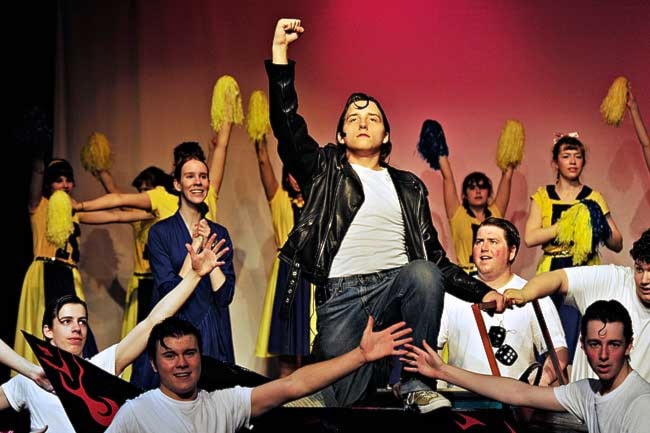There are sensual, sinister garden tools hanging at the Yukon Arts Centre gallery.
Familiar but impractical, their copper handles were cast from antique tools artist Lou Lynn scrounged up, but the working ends are warped.
“The business end came from my head,” she said. “And they have nothing to do with anything.”
A trowel handle ends in a cloven, hoof-shaped trough, while a copper faucet has a trickle of bent frosted glass hanging from it.
The work melds creativity with craftsmanship, and utility with whimsy.
With an eye for architectural objects - Lynn noticed the hooks on the SS Klondike’s paddle wheel after just a few days here -
she started creating cast aluminum and glass objects that look like they’ve been pulled from a shipwreck.
“But cast aluminum is a highly toxic process and I thought there must be another way for me to express my thoughts,” she said.
Lynn started sand casting instead - carving shapes from Styrofoam, pressing them into sand then filling the cavities with molten glass. Copper became the counterpart because it melts at the same temperature as glass, and fuses with it easily.
But Lynn wanted to hone her craft and push glass further, eventually creating heavy glass handles for her distorted copper shapes. She learned to blow the smooth weighty bulbs at Pilchuck Glass School, near Seattle, Washington.
“Now I am getting more of the sophistication I was after,” said Lynn, whose quirky tools were featured in the Lee Valley catalogue this year.
A warm glow emanates from the room next to Lynn’s frosty glass and metal exhibit.
Hanging over a bed of Prairie wheat, a giant rice-paper lantern softly illuminates notions of peace.
“I’ve chosen eight words as a point of departure to start thinking about peace,” said artist Amy Loewan. “Compassion, kindness, respect, understanding, patience, tolerance, gentleness and forgiveness.”
The words were written in 30 different languages and woven into the rice paper. Large shadows of calligraphy were outlined on several of the lantern’s six sides.
“It’s my own calligraphy,” said Loewan, drawing the Chinese symbol for heart on a piece of paper.
A deformed circle with squiggly lines coming out and a knife hanging over it, the character is theatrical.
“It has to do with feeling, compassion, grief and, also, thinking,” said Loewan.
A woven rice-paper scroll hangs on a wall at the gallery entrance, also by Loewan, using the same eight words.
Reproduced in Sanskrit, Hindi and Latin, as well as a host of other languages, the words were printed using different computer scripts, and then woven into the hand-folded rice paper.
“So we have an interrelation of modern technology with the basic elements of rice paper, ink and charcoal,” she said.
The artwork moves from dark to light as it ascends and the words can be moved, so it shifts, said Loewan.
“And that’s the idea of peace, we have to make shifts.”
In the gallery’s third room, tiny wooden models of buildings from across Canada are flanked by photos of the actual structures in operation.
The show focuses on regional responses to sustainable architecture, and Dawson City’s Danoja Zho Cultural Centre was a showcase for the North.
The show is about regionalism and sustainability, which is a bit esoteric, said Jack Kobayashi, who designed the building with partner Tony Zedda.
Kobayashi compared his style of architecture to the 100-mile diet.
“We’re building closer to home,” he said. “We use local materials and are mindful of local culture.”
It’s a far cry from architecture 120 years ago, he said.
“Back then, if you asked an architect to design a bank, they’d start designing a Greek temple,” said Kobayashi.
“But that doesn’t make sense - why would you have a Greek temple in downtown Toronto?”
Eventually a counter-movement formed in Europe, modernizing architecture. North America got wind of it and ran with it, he said.
“That’s why we ended up with all these glass boxes.”
Then, when the 1970s hit, another counter movement formed against the original counter movement.
“It tried to bring back the classical,” said Kobayashi. “But that was totally futile and useless.”
Buildings need a sense of place, he said.
“You can’t have anonymous glass boxes everywhere in the world.”
The Danoja Zho Cultural Centre’s circular building with its wooden slabs reaching toward the sky has a distinct First Nation feel.
“First Nation people in Dawson are waiting to tell their story of the gold rush,” said Kobayashi.
Driving up the Alaska Highway or hiking the Chilkoot Pass, people hear lots about the gold rush, but not a word about First Nations, he said.
“And this was an opportunity for them to tell their story.”
But when Kobayashi and Zedda presented their design to Dawson, town officials balked.
It didn’t meet Dawson’s historic guidelines, said Kobayashi.
Dawson’s Edwardian-style architecture migrated north with the miners from Seattle and other US cities.
“People think it’s regional, but it’s really vernacular,” he said.
Kobayashi and Zedda fought the town, arguing that an Edwardian style was not regional, and won.
“It was a victory for First Nations and a victory for regional architecture,” said Kobayashi.
The three exhibits are at the Yukon Arts Centre gallery until October 24th.
Contact Genesee Keevil at
gkeevil@yukon-news.com
